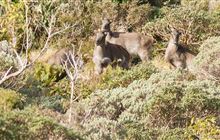NZCA supports DOC’s tahr control operations in National Parks
Introduction
21 July 2020: The NZCA fully supports the Department of Conservation in their operations to cull all tahr, as far as possible, in the Aoraki/Mt Cook and Westland Tai Poutini National Parks.“At this point in the discussion, the NZCA has a duty to bring to light the ecological imperative to immediately control tahr populations in th ese National Parks”, says Edward Ellison, Chair of the NZCA.
“National Parks provide a safe haven for Aotearoa’s native species, and the Department of Conservation has not only a moral, but a legal obligation to ensure that this protection is robust.”
“The intricacies and interconnectedness of an ecosystem cannot be taken for granted when discussing the place of tahr in our National Parks. Himalayan Tahr were introduced to New Zealand in 1904, and so our native flora are illequipped to defend against these grazing mammals.”
“The grazing behaviour of tahr damages endemic flora, such as Tall Tussock, Mount Cook buttercup, NZ Veronica, and Godley’s buttercup, which is classed by the NZ Plant Conservation Network as threatened and nationally endangered. This damage has lasting implications for a variety of fauna including insects, moths, birds, and alpine lizards.”
“The loss of these alpine plants will have irreversible effects on insects and moths; the Aciphylla weevil, for example, feeds exclusively on members of the Aciphylla genus, so the loss of the plant is likely to result in the loss of this insect species.”
“These invertebrates are a food source for birds and lizards; alpine skinks and geckos are attracted to the region during the short alpine flowering season, they are extremely rare and relatively newly discovered. Meanwhile, fruit produced in these alpine regions provides food for native birds such as kea, tui, parakeet, and bellbird.”
“With the impending escalation of climate change effects, we must do all we can now to ensure that these endemic and native species are provided the protection assured to them under the status of National Park.”
“Controlling tahr numbers in National Parks to the lowest practical densities, as far as possible, and to a maximum of 10,000 across the feral range, as stipulated in the Himalayan Tahr Control Plan 1993, will provide opportunity for Aotearoa’s biodiversity to thrive, ensuring the enjoyment of these National Parks for generations to come.”
“The current situation with Covid-19 continues to require significant restrictions on New Zealand’s borders, and will see the hunting tourism industry on hold for an undetermined amount of time. When this industry is able to restart, there will still be bull tahr to hunt across at least 558,000 hectares of New Zealand, outside of the National Parks, which comprise just 21% of the tahr feral range.”
“In addition to this, and prior to Covid-19, location data from Aerial Assisted Trophy Hunting concessionaires reveals that an average of only 67 bull tahr were declared shot per year in these two National Parks over the last five years.”
“The hunting tourism industry that takes place within National Parks, is a niche one, for which the ecological sacrifice cannot be justified.”
Background information
The New Zealand Conservation Authority Te Pou Atawhai Taiao O Aotearoa was established under the Conservation Act 1987, with members appointed by the Minister of Conservation. The NZCA has a role as an objective advocate on matters of national significance and interest in the conservation arena. They provide high quality independent advice to the Minister of Conservation and to the Department of Conservation on its strategic direction and performance.

